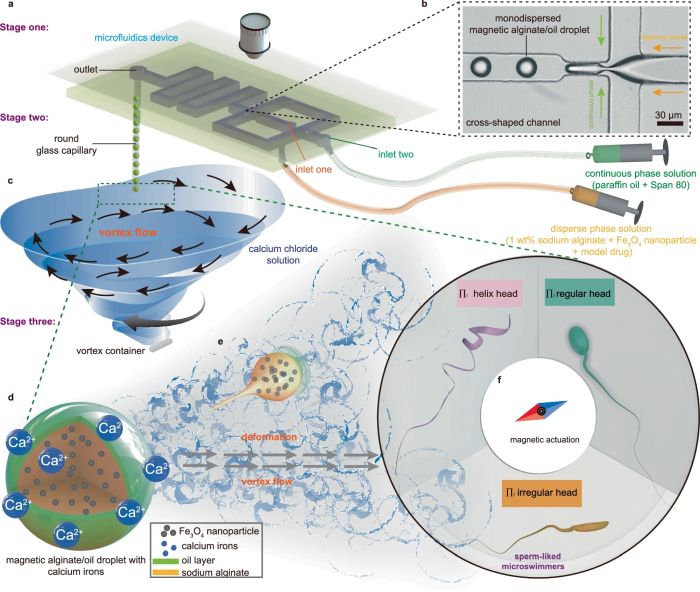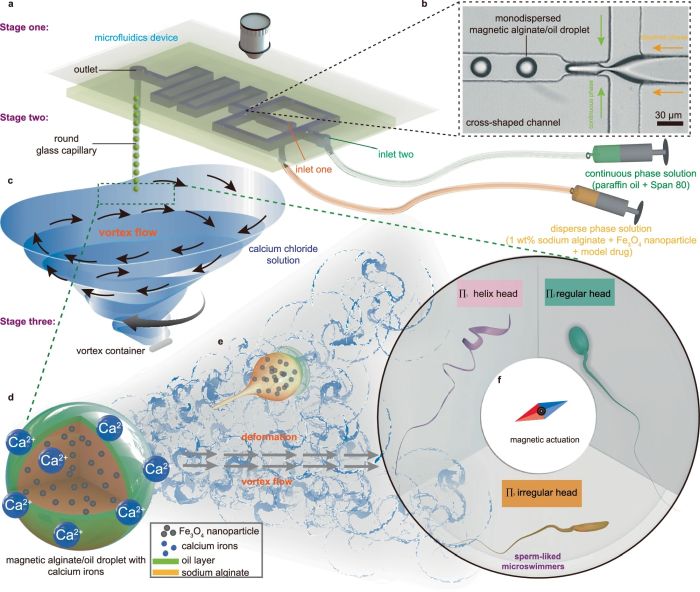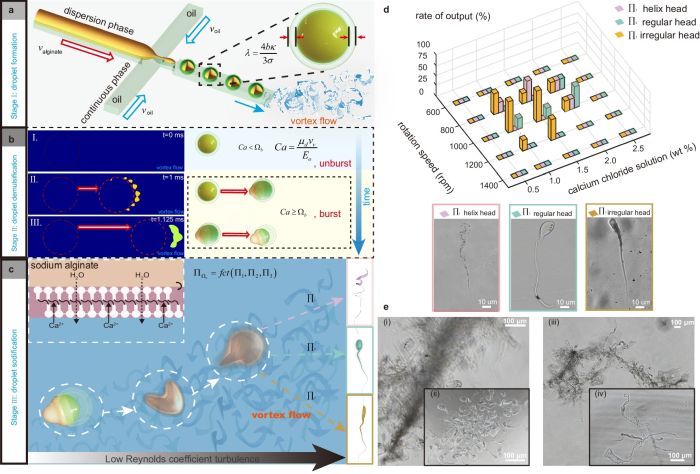
05 Jun Fabrication of Sperm-like Magnetic Microswimmers Using Microfluidics
Microswimmers are tiny robotic entities designed to move through fluids, and they hold significant promise for applications such as targeted drug delivery and minimally invasive surgery. Recent advancements in micro-robotics have paved the way for significant developments in biomedical applications. Among these, the creation of microswimmers capable of precise motion and efficient drug delivery has garnered substantial attention. In a recent study published in Nature Communications, researchers have detailed the fabrication and functionality of polymorphous sperm-like magnetic microswimmers (PSMs) using a microfluidic device named vortex turbulence-assisted microfluidic (VTAM) platform. This work demonstrates a sophisticated approach to designing microswimmers with enhanced propelling, loading, and releasing capabilities, suitable for various biomedical treatments.
The design of the PSMs is inspired by the natural morphology and function of spermatozoa, featuring an asymmetrical structure with a flexible tail and a core-shell head. This design enables the PSMs to achieve both effective propulsion and substantial material loading capabilities in low Reynolds number environments.
“Inspired by the morphology and biofunction of spermatozoa, we report a one-step formation strategy of polymorphous sperm-like magnetic microswimmers (PSMs) by developing a vortex turbulence-assisted microfluidics (VTAM) platform. The fabricated PSM is biodegradable with a core-shell head and flexible tail, and their morphology can be adjusted by vortex flow rotation speed and calcium chloride solution concentration.“, the authors explained.
The VTAM platform used for fabricating these microswimmers comprises a cross-shaped microfluidic chip connected to a vortex container via a round glass capillary. The process begins with the formation of monodispersed magnetic alginate/oil droplets within the microfluidic chip. The droplets are created by introducing an alginate solution mixed with Fe3O4 nanoparticles (20 wt%) and a model drug into one inlet of the chip, while paraffin oil mixed with Span 80 (2–2.5 wt%) is introduced into another inlet. The shear and squeeze actions at the cross-shaped channel result in the formation of uniform droplets.

“a Chip-based microfluidics consisting of a simple PDMS and a glass slide enables in control alginate/oil droplet, where it is transported into a vortex calcium chloride solution by a glass capillary. b The enlarged image of cross-shaped channel for droplet formation. c A round glass capillary as a connector, led out from the chip outlet, and placed vertically in a vortex container filled with calcium chloride solution. The droplet flows along the capillary inner and drops into the vortex turbulence environment for suffering fluid impacts from all directions. d, e Uncalcified droplets are broken and deformed by vortex flow, and the alginate chains undergo a tight cross-linking reaction with calcium ions. f During the process of the gelation, vortex flow assisted the formation of polymorphous sperm-liked microswimmers, including Π1: hellix head, Π2: regular head, Π3: irregular head.” Reproduced from Tan, R., Yang, X., Lu, H. et al. One-step formation of polymorphous sperm-like microswimmers by vortex turbulence-assisted microfluidics. Nat Commun 15, 4761 (2024). under a CC BY 4.0 Attribution 4.0 International license
Fabrication Stages
1- Encapsulated Droplet Production:
The microfluidic chip’s cross-shaped channel is optimized to ensure the uniformity and appropriate size of the droplets. Parameters such as channel width and the two-phase flow rate ratio are carefully controlled to produce droplets with a diameter of approximately 35–40 µm, which is ideal for effective locomotion and material loading.
2- Slender Tail Extraction:
The formed droplets are transferred into a vortex container filled with a calcium chloride solution through a vertically fixed glass capillary. The vortex flow impacts the droplets, causing the oil layer to burst and the inner components (magnetic alginate solution) to be exposed to the calcium chloride solution. This exposure leads to the extraction of a slender tail from the droplets.
3- PSMs Solidification:
The solidification process occurs within milliseconds as a result of the cross-linking reaction between the deformed droplets and the calcium ions in the solution. The solidification speed, which dictates the final structure of the microswimmer, is influenced by the calcium ion concentration. Higher concentrations result in quicker solidification and immediate gelation, while lower concentrations lead to irregularly shaped microswimmers due to slower gelling.
The diverse shapes of the PSMs, including helix, regular, and irregular heads, are achieved by adjusting the calcium chloride concentration and the rotation speed of the vortex flow. This versatility in shape formation enhances the functionality of the microswimmers for various applications.

“a Schematic representation of alginate/oil droplet formation. The different thickness of hydrogel-oil is defined by 𝜆=4𝑏𝜅/3σ. The alginate/oil droplet are fabricated by cross-shaped channel. b Schematic representation of the demulsification stage starts on alginate/oil droplets. A COMSOL simulation of the demulsification process of the hydrogel-oil droplets in low Reynolds coefficient turbulence (Supplementary Movie 1). (I) A critical capillary value Ω𝑏 is defined to describe the hydrogel-oil droplet state, which is remain steady when 𝐶𝑎<Ω𝑏 and burst when 𝐶𝑎≥Ω𝑏. (II) The gap appearing in an ultra-thin oil membrane is observed at 1 millisecond moment. Then, with the increase of flow strength, the droplet deformation can be observed in the instantaneous environment. (III) The inside hydrogel phase outflows from fragmentized oil membrane. c The hydrogel phase could be solidified to form PSMs by cross-linking reaction. d The probability of PSMs productive formation by adjusting vortex flow rotation speed and calcium chloride solution concentration. The morphology of PSMs. e The mass production of PSMs.” Reproduced from Tan, R., Yang, X., Lu, H. et al. One-step formation of polymorphous sperm-like microswimmers by vortex turbulence-assisted microfluidics. Nat Commun 15, 4761 (2024). under a CC BY 4.0 Attribution 4.0 International license
The study demonstrates that the VTAM approach can produce biocompatible, asymmetrical magnetic microswimmers with integrated flexible tails in a single step. These PSMs exhibit excellent motion capabilities and sustained release properties, making them suitable for targeted drug delivery. The research highlights the potential of these microswimmers in providing a reliable and controllable method for delivering drugs and biologics to specific sites within the body.
“Using vortex turbulence-assisted microfluidics to fabricate sperm-like microswimmer with effective propelling, desirable loading and adaptive releasing abilities all in one, would inspire the following researchers to develop other sophisticated polymorphous structures fabrication that cannot be achieved by conventional laminar flow. It’s worth mentioning that this manuscript mainly focuses on the proof of concept of the fabrication process. Compared to the conventional microcapsule fabrication approaches, there is a lot of room for improvement, such as fabrication controllability, stability, unity, and productivity.“, the authors concluded.
Figures are reproduced from Tan, R., Yang, X., Lu, H. et al. One-step formation of polymorphous sperm-like microswimmers by vortex turbulence-assisted microfluidics. Nat Commun 15, 4761 (2024). https://doi.org/10.1038/s41467-024-49043-0 under a CC BY 4.0 Attribution 4.0 International license.
Read the original article: One-step formation of polymorphous sperm-like microswimmers by vortex turbulence-assisted microfluidics
For more insights into the world of microfluidics and its burgeoning applications in biomedical research, stay tuned to our blog and explore the limitless possibilities that this technology unfolds. If you need high quality microfluidics chip for your experiments, do not hesitate to contact us.


